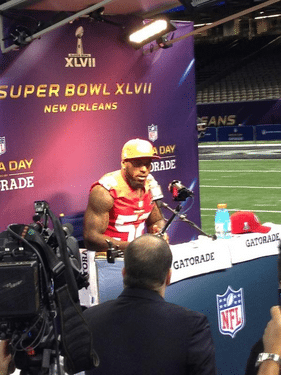 |
| Photo: @ESPN_RobKing |
The San Francisco 49ers and the Baltimore Ravens have a few days yet to obsess on their football schemes before they meet on Sunday to see who will win Super Bowl XLVII.
But for the massive squad of PR execs who are responsible for Super Bowl Media Day, the preparation is over and the ultimate test is at hand.
Super Bowl Media Day kicked off Tuesday morning at the Mercedes-Benz Superdome.
For the thousands of journalists attending the festivities, there’s no shortage of stories to sink their teeth into, ranging from the first Super Bowl featuring opposing head coaching brothers, Baltimore's John Harbaugh and San Francisco's Jim Harbaugh, to the pending retirement of the Ravens' All-Pro (and outspoken) linebacker Ray Lewis.
And while Super Bowl Media Day has a circus-like atmosphere, there are a few lessons for communications execs — regardless of the market they traffic in — when it comes to steering a media scrum and pulling off a successful press conference:
-
Build a microsite in advanced of the press conference: When you’re handling a press conference that will draw at least a few dozen journalists it’s probably best to create a microsite that has every last detail about the press conference, such as when it starts; when it stops; whether there are any conditions or limitations on questioning and who among the PR staff can answer any logistical questions.
-
Make sure the room is big enough to handle the turnout: Nothing ticks off a reporter more than attending a press conference and having a boom microphone whack him in the head because the PR team tried to pack ten pounds of journalists into a five-pound bag. If the story has any legs, a press conference is likely to attract more journalists than you initially anticipated. In fact, bet on it. So, make sure that there is ample room for all of the players involved, including reporters, broadcasters, radio reps and, of course, the people who are going to be answering the questions, such as your management team.
-
Following up prevents any potential fumbles in the coverage: During a press conference with lots of journalists attending, there may be some information and/or content that get lost in the translation. Keep the microsite up for a few days or weeks after the press conferences so journalists have a destination to check any facts, quotations or metrics. Perhaps more important, have your PR team follow-up with key journalists who cover the area/market/company to ensure, in the traditional PR parlance, “that they got everything they need.”
Follow Matthew Schwartz: mpsjourno1
